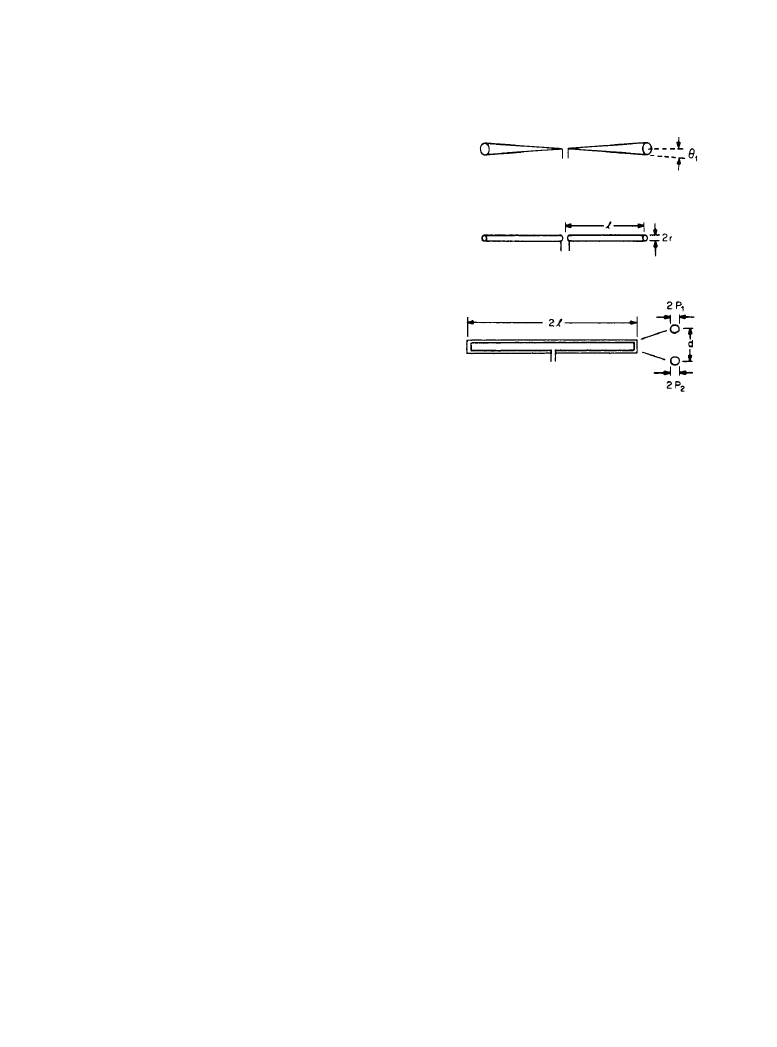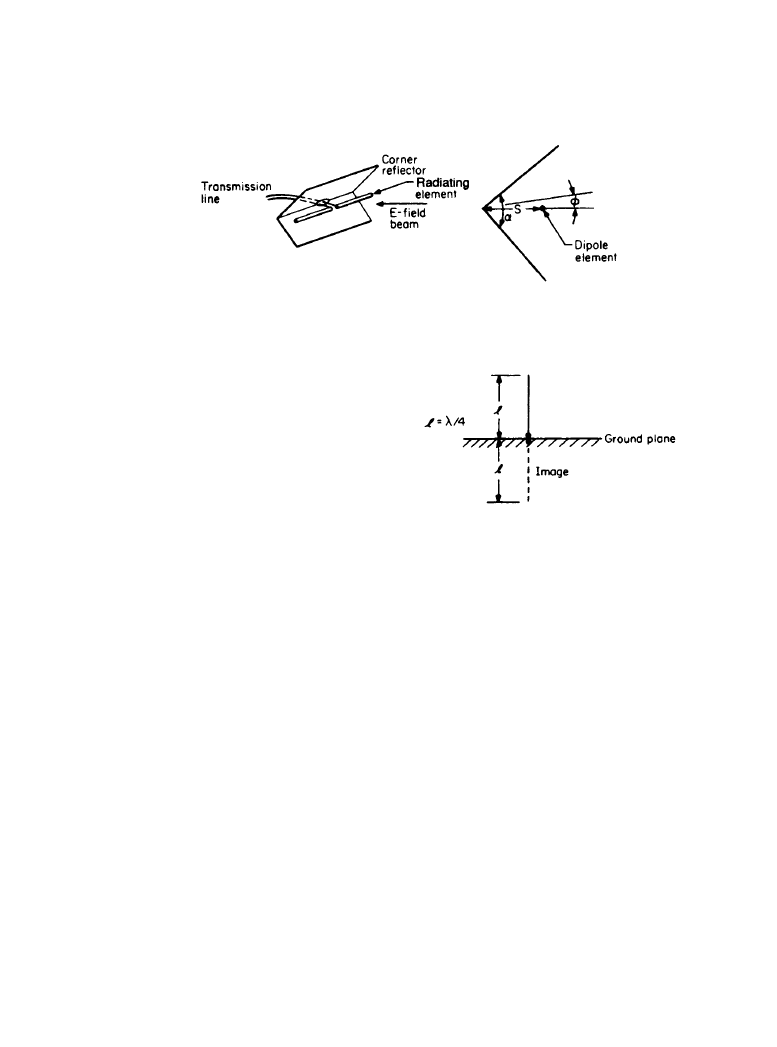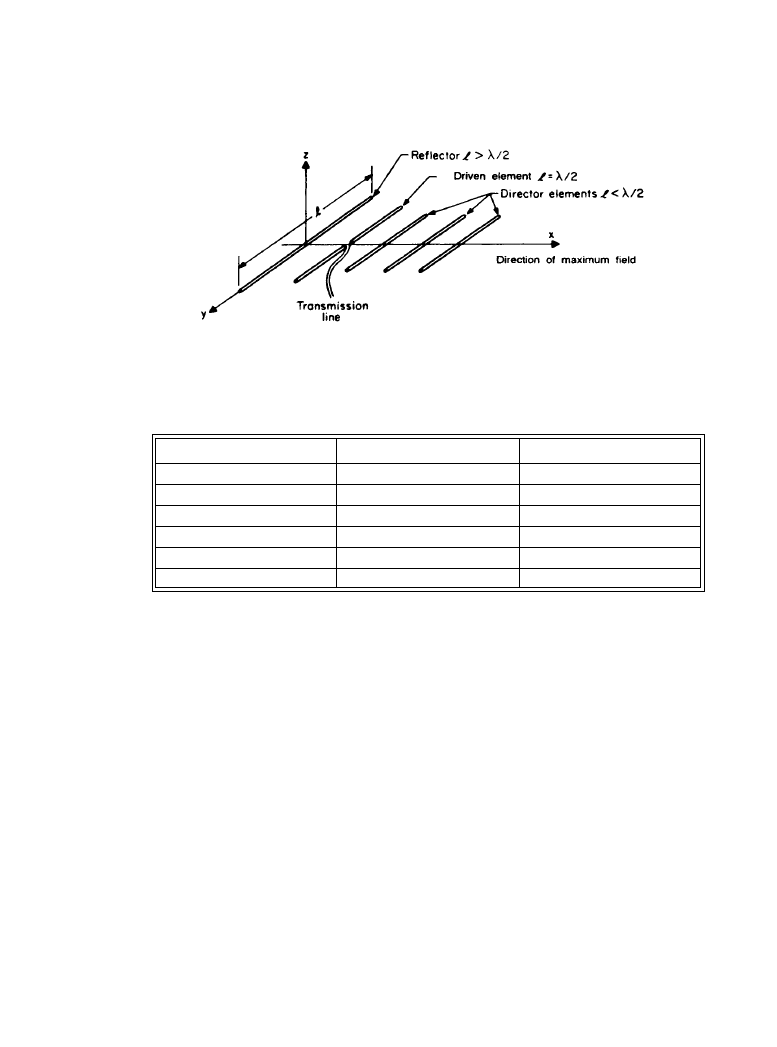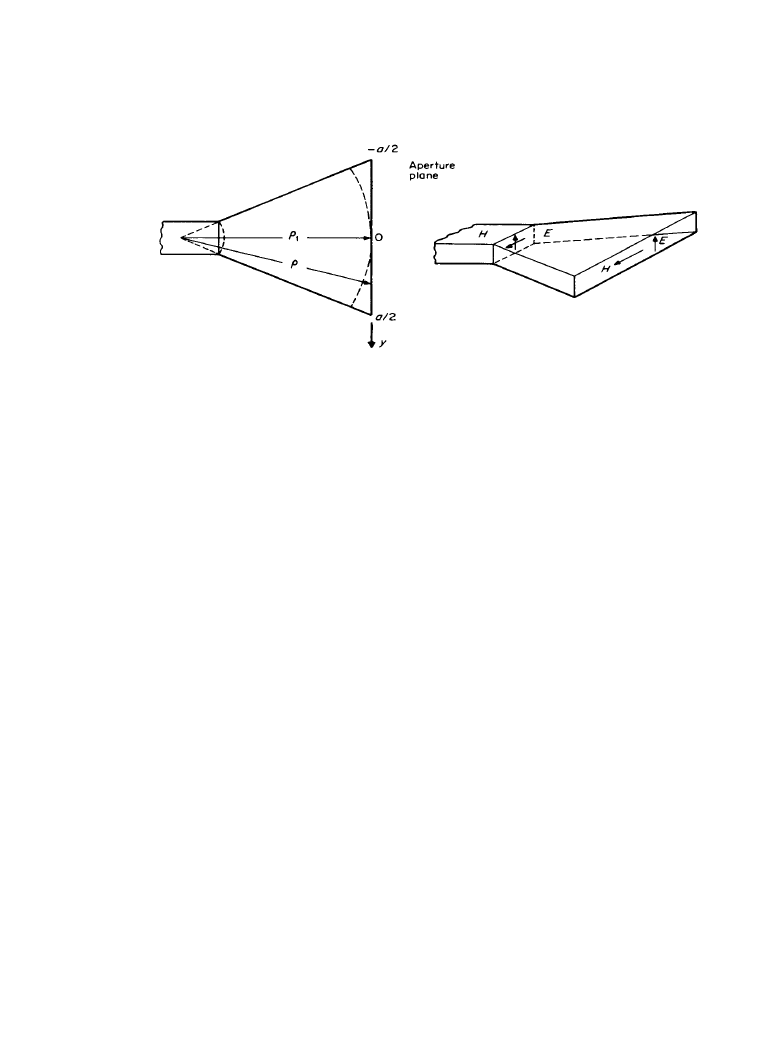ВУЗ: Казахская Национальная Академия Искусств им. Т. Жургенова
Категория: Книга
Дисциплина: Не указана
Добавлен: 03.02.2019
Просмотров: 21650
Скачиваний: 19

11-112 Broadcast Transmission Systems
nected to the closely-coupled 1/2-wave element act as a matching stub between the transmission
line and the single-piece 1/2-wave element. This broadbands the folded dipole antenna by a fac-
tor of 2.
A corner-reflector antenna may be formed as shown in Figure 11.5.8. A ground plane or flat
reflecting sheet is placed at a distance of 1/16- to 1/4-wavelengths behind the dipole. Gain in the
forward direction can be increased by a factor of 2 with this type of design.
11.5.3a Quarter-Wave Monopole
A conductor placed above a ground plane forms an image in the ground plane such that the
resulting pattern is a composite of the real antenna and the image antenna (see Figure 11.5.9).
The operating impedance is 1/2 of the impedance of the antenna and its image when fed as a
physical antenna in free space. An example will help illustrate this concept. A 1/4-wave mono-
pole mounted on an infinite ground plane has an impedance equal to 1/2 the free-space imped-
ance of a 1/2-wave dipole. It follows, then, that the theoretical characteristic resistance of a 1/4-
wave monopole with an infinite ground plane is 37
Ω.
For a real-world antenna, an infinite ground plane is neither possible nor required. An antenna
mounted on a ground plane that is 2 to 3 times the operating wavelength has about the same
impedance as a similar antenna mounted on an infinite ground plane.
11.5.3b
Log-Periodic Antenna
The log-periodic antenna can take-on a number of forms. Typical designs include the conical log
spiral, log-periodic V, and log-periodic dipole. The most common of these antennas is the log-
periodic dipole. The antenna can be fed either by using alternating connections to a balanced
line, or by a coaxial line running through one of the feeders from front-to-back. In theory, the
log-periodic antenna may be designed to operate over many octaves. In practice, however, the
upper frequency is limited by the precision required in constructing the small elements, feed
lines, and support structure of the antenna.
Figure 11.5.6
Half-wave dipole antenna: (
a) coni-
cal dipole; (
b) conventional dipole.
(
a)
(
b)
Figure 11.5.7
Folded dipole antenna.
Downloaded from Digital Engineering Library @ McGraw-Hill (www.digitalengineeringlibrary.com)
Copyright © 2004 The McGraw-Hill Companies. All rights reserved.
Any use is subject to the Terms of Use as given at the website.
Transmitting Antennas

Transmitting Antennas 11-113
11.5.3c
Yagi-Uda Antenna
The Yagi-Uda is an end-fire array consisting typically of a single driven dipole with a reflector
dipole behind the driven element, and one or more parasitic director elements in front (Figure
11.5.10). Common designs use from one to 7 director elements. As the number of elements is
increased, directivity increases. Bandwidth, however, decreases as the number of elements is
increased. Arrays of more than 4 director elements are typically narrowband.
The radiating element is 1/2-wavelength at the center of the band covered. The single reflec-
tor element is slightly longer, and the director elements are slightly shorter, all spaced approxi-
mately 1/4-wavelength from each other.
Table 11.5.1 demonstrates how the number of elements determines the gain and beamwidth of
a Yagi-Uda antenna.
11.5.3d
Waveguide Antenna
The waveguide antenna consists of a dominant-mode-fed waveguide opening onto a conducting
ground plane. Designs may be based on rectangular, circular, or coaxial waveguide (also called
an annular slot). The slot antenna is simplicity itself. A number of holes of a given dimension are
placed at intervals along a section of waveguide. The radiation characteristics of the antenna are
determined by the size, location, and orientation of the slots. The antenna offers optimum reli-
ability because there are no discrete elements, except for the waveguide section itself.
Figure 11.5.8
Corner-reflector antenna.
Figure 11.5.9
Vertical monopole mounted
above a ground plane.
Downloaded from Digital Engineering Library @ McGraw-Hill (www.digitalengineeringlibrary.com)
Copyright © 2004 The McGraw-Hill Companies. All rights reserved.
Any use is subject to the Terms of Use as given at the website.
Transmitting Antennas

11-114 Broadcast Transmission Systems
11.5.3e
Horn Antenna
The horn antenna can be considered a natural extension of the dominant-mode waveguide feed-
ing the horn in a manner similar to the wire antenna, which is a natural extension of the two-wire
transmission line. The most common types of horns are the E-plane sectoral, H-plane sectoral,
pyramidal horn (formed by expanding the walls of the TE
0,1
-mode-fed rectangular waveguide),
and the conical horn (formed by expanding the walls of the TE
1,1
-mode-fed circular waveguide).
The H-plane sectoral horn is shown in Figure 1.5.11. Dielectric-loaded waveguides and horns
offer improved pattern performance over unloaded horns. Ridged and tapered horn designs
improve the bandwidth characteristics. Horn antennas are available in single and dual polarized
configurations.
11.5.3f
Reflector Antenna
The reflector antenna is formed by mounting a radiating feed antenna above a reflecting ground
plane. The most basic form of reflector is the loop or dipole spaced over a finite ground plane.
This concept is the basis for the parabolic or spherical reflector antenna. The parabolic reflector
antenna can be fed directly or through the use of a subreflector in the focal region of the parab-
ola. In this approach, the subreflector is illuminated from the parabolic surface. The chief disad-
Figure 11.
5.10
The Yagi-Uda array.
Table 11.5.1 Typical Characteristics of Single-Channel Yagi-Uda Arrays
Number of Elements
Gain, dB
Beamwidth, Degrees
2
3 to 4
65
3
6 to 8
55
4
7 to 10
50
5
9 to 11
45
9
12 to 14
37
15
14 to 16
30
Downloaded from Digital Engineering Library @ McGraw-Hill (www.digitalengineeringlibrary.com)
Copyright © 2004 The McGraw-Hill Companies. All rights reserved.
Any use is subject to the Terms of Use as given at the website.
Transmitting Antennas

Transmitting Antennas 11-115
vantage of this design is the aperture blockage of the subreflector, which restricts its use to large
aperture antennas. The operation of a parabolic or spherical reflector antenna is typically
described using physical optics.
Parabolic-reflector antennas are usually illuminated by a flared-horn antenna with a flare
angle of less than 18°. A rectangular horn with a flare angle less than 18° has approximately the
same aperture field as the dominant-mode rectangular waveguide feeding the horn.
11.5.3g
Spiral Antenna
The bandwidth limitations of an antenna are based on the natural change in the critical dimen-
sions of the radiating elements caused by differing wavelengths. The spiral antenna overcomes
this limitation because the radiating elements are specified only in angles. A two-arm equiangu-
lar spiral is shown in Figure 11.5.12. This common design gives wideband performance. Circular
polarization is inherent in the antenna. Rotation of the pattern corresponds to the direction of the
spiral arms. The gain of a spiral antenna is typically slightly higher than a dipole.
The basic spiral antenna radiates on both sides of the arms. Unidirectional radiation is
achieved through the addition of a reflector or cavity.
11.5.3h
Array Antenna
The term “array antenna” covers a wide variety of physical structures. The most common config-
uration is the planar array antenna, which consists of a number of radiating elements regularly
spaced on a rectangular or triangular lattice. The linear array antenna, where the radiating ele-
ments are placed in a single line, is also common. The pattern of the array is the product of the
element pattern and the array configuration. Large array antennas may consist of 20 or more
radiating elements.
Correct phasing of the radiating elements is the key to operation of the system. The radiating
pattern of the structure, including direction, can be controlled through proper adjustment of the
relative phase of the elements.
Figure 11.5.11
Geometry of an
H-plane sectoral horn.
Downloaded from Digital Engineering Library @ McGraw-Hill (www.digitalengineeringlibrary.com)
Copyright © 2004 The McGraw-Hill Companies. All rights reserved.
Any use is subject to the Terms of Use as given at the website.
Transmitting Antennas

11-116 Broadcast Transmission Systems
11.5.4 AM Broadcast Antenna Systems
Vertical polarization of the transmitted signal is used for AM broadcast stations because of its
superior groundwave propagation, and because of the simple antenna designs that it affords. The
FCC and licensing authorities in other countries have established classifications of AM stations
with specified power levels and hours of operation. Protection requirements set forth by the FCC
specify that some AM stations (in the U.S.) reduce their transmitter power at sunset, and return to
full power at sunrise. This method of operation is based on the propagation characteristics of AM
band frequencies. AM signals propagate further at nighttime than during the day.
The different day/night operating powers are designed to provide each AM station with a
specified coverage area that is free from interference. Theory rarely translates directly into prac-
tice insofar as coverage is concerned, however, because of the increased interference that all AM
stations suffer at nighttime.
The tower structure visible at any AM radio station transmitter site is only half of the antenna
system. The second element is a buried ground system. Current on a tower does not simply dis-
appear, rather it returns to earth through the capacitance between the earth and the tower. Ground
losses are greatly reduced if the tower has a radial copper ground system. A typical single tower
ground system is made up of 120 radial ground wires each 140 electrical degrees long (at the
operating frequency) equally spaced out from the tower base. This is often augmented with an
additional 120 interspersed radials 50 ft long.
11.5.4a
Directional AM Antenna Design
When a non-directional antenna with a given power does not radiate enough energy to serve the
station's primary service area, or radiates too much energy toward other radio stations on the
same or adjacent frequencies, it is necessary to employ a directional antenna system. Rules set
out by the FCC and regulatory agencies in other countries specify the protection requirements to
be provided by various classes of stations, for both daytime and nighttime hours. These limits
tend to define the shape and size of the most desirable antenna pattern.
A directional antenna functions by carefully controlling the amplitude and phase of the RF
currents fed to each tower in the system. The directional pattern is a function of the number and
spacing of the towers (vertical radiators), and the relative phase and magnitude of their currents.
The number of towers in a directional AM array can range from two to six or even more in a
Figure 11.5.12
Two-arm equiangular spiral antenna.
Downloaded from Digital Engineering Library @ McGraw-Hill (www.digitalengineeringlibrary.com)
Copyright © 2004 The McGraw-Hill Companies. All rights reserved.
Any use is subject to the Terms of Use as given at the website.
Transmitting Antennas